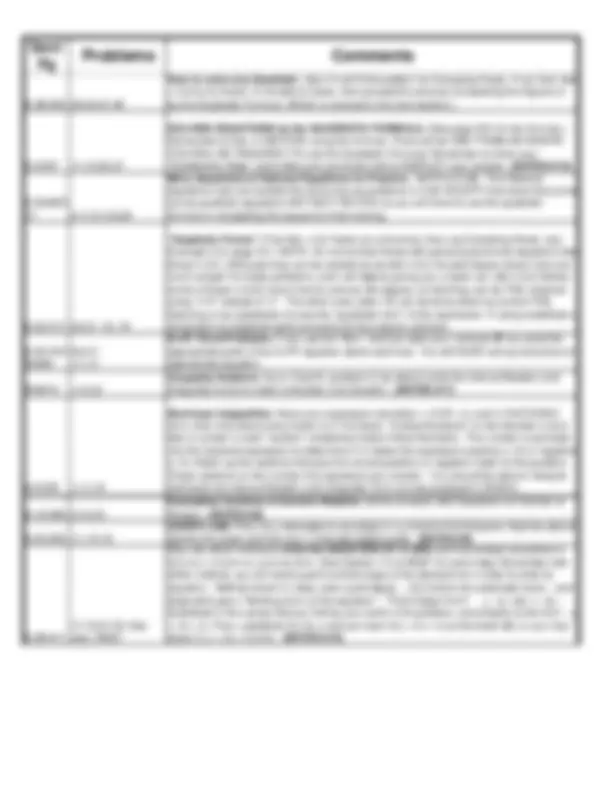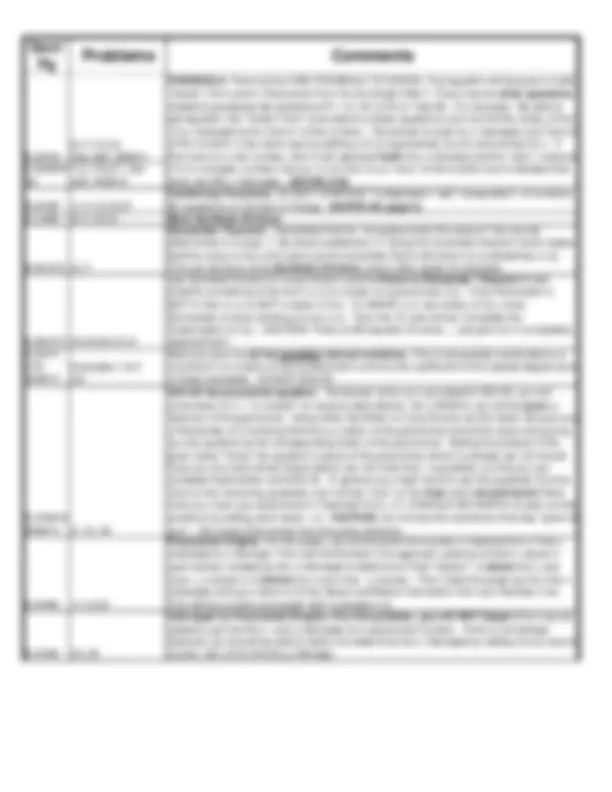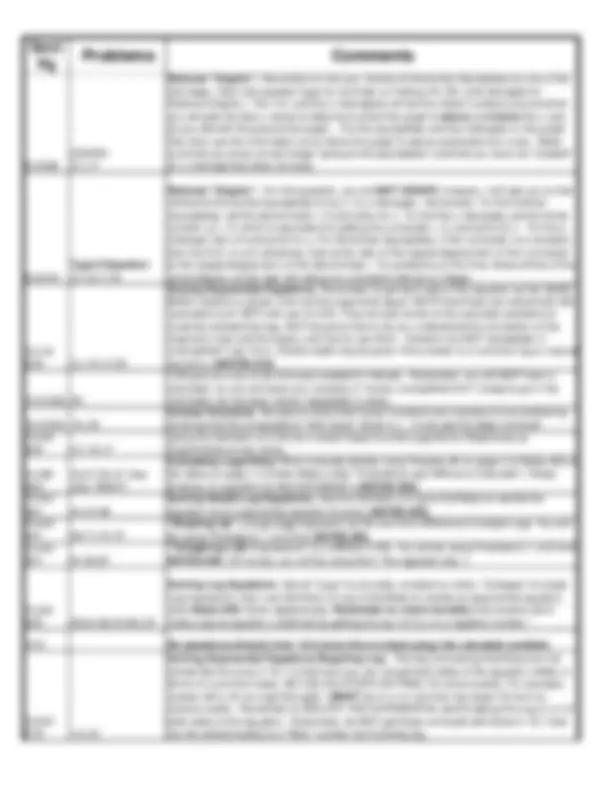





Study with the several resources on Docsity

Earn points by helping other students or get them with a premium plan


Prepare for your exams
Study with the several resources on Docsity

Earn points to download
Earn points by helping other students or get them with a premium plan
Community
Ask the community for help and clear up your study doubts
Discover the best universities in your country according to Docsity users
Free resources
Download our free guides on studying techniques, anxiety management strategies, and thesis advice from Docsity tutors
Material Type: Exam; Professor: White; Class: Precalculus Algebra; Subject: Mathematics (MS); University: Jacksonville State University; Term: Fall 2008;
Typology: Exams
1 / 6

This page cannot be seen from the preview
Don't miss anything!




on use of ^ to show powers
The only way I can do exponents in this guide is to use ^ to indicate a power like most of your calculators do.
Linear Inequalities & Compound Inequalities. Remember when solving linear inequalities, if you multiply (or divide) both sides by a negative number, the inequality symbol must be reversed. "AND" statements are intersections of the two solution sets, that is where they "overlap." "OR" statements are unions, which contains everything that is in either one of the sets or in both of them. Continued Inequalities, with b & c being Real Numbers, b<A<c, where A is an expression containing the unknown x, are actually "AND" statements: b<A AND A<c; however, these are simple enough to work "as a unit" by isolating x "in the middle." Work as you would an inequality (Remember to reverse inequality direction if multiplying or dividing by a negative number.) Be sure to do each operation in "All 3 sections" (left, middle, right.) The answer should have x "between 2 numbers."
Absolute Value Equations & Inequalities. For solving absolute value equations equal to some positive number c, remember that exactly what is inside the absolute value must be set equal to each of c and to -c since the absolute value of each of these is c. So this creates TWO equations to be solved and TWO solutions. If c is positive and |A|>c, then either A>c OR A<-c. Solve these inequalities separately and take the union that is indicated by "OR." If c is positive and |A|<c, then -c<A<c can be solved as described in 2.6 above. In either inequatility case, be able to show the solution set on a Number Line and give the answer as a simplified inequality or in interval notation, as required.
3,9,15,37,47,57; See also WS#1 & #
(This section was not technically covered; however, the techniques were used in some problems. ) Sums of Rationals & Complex Rationals. (Adding & Subtracting Algebraic Fractions) Remember to factor denominators in order to find the Least Common Denominator, and leave them in factored form. CAUTION: Do not confuse this with SOLVING rational equations (4.6) where you can multiply by the LCD and "remove the fractions" from the equation in order to have a simpler equation to solve. Here (4.5), you are adding (or subtracting) "fractions", so you must keep exact equality to the original expression and your answer will almost always still be a "fraction." (NOTES #1 & #2)
Polynomial Long Division. Not all division problems can be done by Synthetic Division, so it is important to understand this procedure. Please follow the method shown in class of putting the changed signs for subtraction in "circles." Remember you might want to put 0x^n for any missing powers of x in the divisor or dividend so that like terms stay lined up properly for subtraction. (NOTES #3)
Synthetic Division (which can be done by Long Division) If you choose to use Synthetic Division on some types of problems, remember that the divisor MUST be of the form (x-c) and "c" is the "number" that is used for the divisor. Also remember to place "0's" for any "missing" degrees of x in the dividend. (NOTES #4)
Solving Rational Equations : Multiply by the LCD, then evaluate what kind of equation you have to solve. If it is Quadratic, set = 0, Factor & Solve. (See NOTE to 6.5B!) If asked for "Restrictions", remember these are the values of x that would make the denominator 0. Remember to Mentally Check your answer against the original equation or these "Restrictions" to make sure it doesn't put a 0 in the denominator and make the equation undefined. CAUTION: Do not confuse these problems with adding or subtracting rational expressions (4.5) where you must keep exact equality to the original expression as you proceed. In these problems (4.6), you are SOLVING, so your final answer should be of the form x = a number. (NOTES #5 & #6)
Ratio & Fraction WORD Problems. Remember to Label your unknown and set up a proper equation and solve it.
See also WS#
Integer Exponents. Although this is not technically IN the syllabus, you will find it helpful to go over these problems as a review of the exponent rules. It will help you on the more difficult fractional exponents in 6.6, and also in the exponential and Log work from the end of the semester. REMEMBER that Negative Exponents indicate to invert, NOT to make the number or variable negative.
69,73; See also WS#3, #4 & #
Radicals. Again this is not technically IN the syllabus; but if you need to brush up on your basic radical skills, this is the place to do it. Includes rationalizing square & cube roots of numbers.
5.5/260 1,11,27,29,
Solving Radical Equations : Remember to ISOLATE the Radical BEFORE Squaring or Cubing as needed. FOIL when needed. MUST SHOW CHECK for ANSWERS! (When raising both sides of an equation to an even power.) (NOTES #11)
7,11,19,21,23; See also WS#
Fractional Exponents. When asked to "EVALUATE", your answer should always be a Number.... In this case, there should be no exponents left in your answer. Remember to think about the fractional exponent like a radical in which the denominator tells the Root & the numerator gives the Integer power. You will probably want to get your expression back to a form with correct positive exponents first. Then, whenever possible, take the Root first, then do the integer power, so that your numbers will stay as small as possible. (NOTES #12)
Notation: Changing between Exponent & Radical Form with the above idea in mind. Be careful of order of operations to remember what is actually raised to the power and what is not! (Example: 2x^(1/2) = 2 "times" the square root of x NOT the square root of 2x)
Simplifying Fractional Exponents. Remember to use your exponent rules here. Do NOT put into Radical form. Just apply the rules with the arithmetic in fractions instead of integers as it was in 5.1. Remember to properly evaluate constants (numbers) raised to exponents as you would have in 5.6A. (NOTES #12)
Complex Numbers: (NOT the same as complex fractions!) Remember when working with Complex Numbers that you can not do the same things that you are used to doing with multiplicaion of interiors of radicals if they are NOT positive. Rule of thumb is: change square root of a negative into an "i expression" first, then proceed with the other operations involved. If you think about it, we are again just following a natural order of operations. Denominators must be Rationalized just like Radicals in denominators. (Think: i is just "square root of -1"). The procedures are really just the same: i(i) = i^2 (i squared) which is -1, so we can "remove" i from the denominator in a monomial term by multiplying by i/i (=1). If i is in a binomial term, then we use the idea of a "conjugate" like section 6.4 (a + bi ) is multiplied by(a - bi) to give a^2 -(b^2)(i^2) = a^2 + b^2 since i^2 = -1. Of course, the numerator is multiplied by the same thing so as to always multiply by 1 and maintain equality. (NOTES #13)
6.2A/293 3,9,13 Determining best way to Solve equations. These can be Set = 0, Factored & Solved
EXTRACTING ROOTS: These can be written in the form of something squared = a constant. Remember the idea of "Isolating the thing squared" before taking square root of both sides. Then take square root of both sides. REMEMBER + or -! (NOTE on Chapter 10: Remember that a similar idea is used in some of the problems in Chapter 10 where we need to solve for an unknown that is inside parentheses raised to some power n. Using the idea of extracting roots, we can solve these by taking the nth root of both sides if we have isolated that ( )^n as we isolated the thing squared here. In these applied problems involving money, etc., we will only be concerned with the positive root even in the case of an even power.) (NOTES #14)
SOLVING BY COMPLETING THE SQUARE: Remember to first get the coefficient of "x squared" term to be 1 , then proceed. There will be at least ONE PROBLEM WHERE YOU WILL BE REQUIRED TO SOLVE BY COMPLETING THE SQUARE! (NOTES #15)
Use with: WS# 1,3,7,25,27; Use with: WS#
PARABOLA: There will be ONE PARABOLA TO GRAPH. The equation will be given in both "Vertex" Form and in Polynomial Form for the Graph ONLY. There may be other questions related to parabolas like problems #11, 12, 20, & 22 on Test #2.. For example: Be able to get equation into "Vertex Form" & be able to answer questions such as find the vertex, & the x & y intercepts & the "zero's" of the function. Remember to look for x-intercepts and "zero's" of the function in the same way by setting y=0 (or equivalently f(x)=0) and solving for x. If this value is a real number, then it will represent both the x-intercept and the "zero"; however if it is a complex number (has an i in it), then it is a "zero" of the function but it indicates that there are NO x-intercepts. (NOTES #18)
8.6/448 1,11,13,15,
Combining Functions. DO NOT CONFUSE "multiplication" with "composition" of functions. No questions on Domain or Range. (NOTES #8, page 2) 9.1/468 9,11,15,31 More Synthetic Division
Remainder Theorem: Remember that for f(x)=polynomial, the value of f(a) can be determined in 2 ways: 1. By direct substitution; 2. Using the remainder theorem which states that the value of f(a) is the same as the remainder that is left when f(x) is divided by (x-a). This can be done using Synthetic Division, and is often easier to calculate.
Use Synthetic Division or Long Division and the Factor & Remainder Theorem to test whether something of the form (x-c) is a factor of a polynomial, f(x). If the Remainder is NOT 0, then (x-c) is NOT a factor of f(x). To SHOW (x-c) is a factor of f(x), show Remainder=0 when dividing f(x) by (x-c). Then the "b" part will be: Complete the Factorization of f(x). CAUTION: There is NO equation to solve ... just give f(x) in completely factored form! 9.3/477- 478 WS#
Examples 1 & 2 3,
Here you give me all the possible rational solutions. This is all possible combinations of c/d where c is a factor of the constant term and d is the coefficient of the highest degree term in these examples. DO NOT SOLVE!
SOLVE the poynomial equation. Remember when you are asked to SOLVE, you will come down to x = "a number" (or several alternatives). As in WS#14, you will be given a factor(s) of the polynomial. Using either Synthetic or Long Division by this factor will give you a Remainder of 0 verifying that this is a factor of the polynomial and at the same time giving you the quotient as the corresponding factor of the polynomial. Setting the product of the given factor "times" the quotient in place of the polynomial (which is already set =0) should have you at a level where these factors are not more than a quadratic, so that you can complete factorization and SOLVE. In general you might have to use the quadratic formula here on the remaining quadratic, but I will be "nice" on the final and it should factor! Now once you have your polynomial in Factored Form = 0, it SHOULD BE SIMPLE to pick out the solutions by setting each factor = 0. CAUTION: Do not lose the solution(s) that was "given to you"... the one(s) that comes from the given factor(s).
Polynomial Graphs. For the graph, you will be given the function in factored form. Find x- intercepts & y-intercept. Then use the Number Line approach, picking out test x-values in each section created by the x-intercepts to determine if that "section" is above the x-axis (has + y-values) or is below the x-axis (has - y-values). Then make the graph go thru the x- intercepts and up or down to fit the Above and Below information from your Number Line. This will be a continuous graph with no breaks in it.
Intercepts for Polynomial Graphs: (For this problem, you will NOT Graph.) You may be asked to just find the x- and y-intercepts for a polynomial function. If this is not already factored, you should be able to factor it to determine the x-intercepts by setting f(x)=0; and of course, set x=0 to find the y-intercept.
Rational "Graphs": Remember to find your Vertical & Horizontal Asymptotes as one of the first steps. (See next question type for reminder on finding VA, HA, and intercepts for Rational Graphs.) The V.A. and the x-intercept(s) will be the critical numbers around which you will pick the test x-values to determine where the graph is above and below the x-axis as you did with the polynomial graph. Put the asymptotes and the intercepts on the graph first; then use the information as to where the graph is above and below the x-axis. Make sure that you show correct shape "going to the asymptotes" and that you have not "created" an x-intercept that does not exist.
Type II Question 3,7,9,17,
Rational "Graphs": For this question, you will NOT GRAPH ; however, I will ask you to find Vertical & Horizontal Asymptotes & any x- & y-intercepts. Remember: To find Vertical Asymptotes, set the denominator = 0 and solve for x. To find the x-intercepts, set the whole function (y) = 0, which is equivalent to setting the numerator = 0, and solve for x. For the y- intercept, set x=0 and solve for y. For Horizontal Asymptotes, if the numerator is a constant, then the H.A. is y=0; otherwise, look at the ratio of the largest degree term of the numerator to the largest degree term of the denominator. For problems on the final, these will be of the same degree, so the ratio will reduce to a constant rational or integer.
Solving Exponential Equations. Remember to get each side of the equation as the SAME BASE raised to a power, then set the exponents equal. NOTE that these are solved with NO calculators and NOT with use of LOG. They do look similar to the calculator problems & could be worked that way, BUT the point here is do you understand the connection of the exponent rules and the bases, and how to use them. Answers are NOT acceptable in unsimplified "Log" form. (Partial credit may be given if the answer is in common log or natural log form.) (NOTES #19)
I will give you any of the formulas needed for Interest. Remember, you will NOT have a calculator, so you will leave your answers in "exact, unsimplified form" (ready to go in the calculator) as has been shown repeatedly in class.
10.3/550 19, 23
Inverse Functions: Be able to verify that 2 given functions are inverses of one another by showing that the compositions "both ways" result in x. I must see the steps involved! 10.4A/ 560 3,7,13,
Using the Definition of LOG (to a certain base) to write Logarithmic Statements as Exponentials & vice versa.
23,27,35,37; See also: WS#
Evaluating Logarithms Either evaluate directly using Property #5 on page 2 of Notes #20 or the ideas on page 1 of these Notes under "Evaluating Logs Without a Calculator." (Keep thinking: A Logarithm IS AN EXPONENT!) (NOTES #20) 10.4C/ 561 41,47,
Solving Simple Log Equations: Use the Definition of Log to that Base to rewrite the equation as an exponential equation & solve. (NOTES #20) 10.4D/ 561 69,71,73,
"Breaking Up" a single Log expression as the sum &/or difference of simple Logs. You will be using Proerties 6, 7, & 8 from NOTES #20. 10.4D/ 561 81,85,
"Collapsing LOG Expressions" to a SINGLE LOG. You will be using Proerties 6, 7, & 8 from NOTES #20. (Of course, you will be using them "the opposite way.")
Solving Log Equations : Get all "Logs" to one side, constant on other, "Collapse" to single Log expression, then use Definition of Log to that Base to rewrite as exponential equation. (See Notes #20 ) Solve algebraically. Remember to check mentally that answers don't make original equation undefined by getting the log "of 0 or of a negative number."
10.5 No questions directly from 10.5 since this is a basic plug into calculator problem.
Solving Exponential Equations Requiring Log: The key to knowing that these are not solved like the ones in 10.1 is that here you can not get both sides of the equation written in terms of a common base. NO CALCULATORS ON FINAL! So solve exactly: For example, answer left in #1 as Log[13]/Log[3]. (MUST be in Ln or common log (base 10) form to receive credit.) Remember to ISOLATE THE EXPONENTIAL before taking the Log or Ln of both sides of the equation. Remember, do NOT get these confused with those in 10.1 that can be solved exactly to a "Nice" number not involving log.